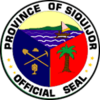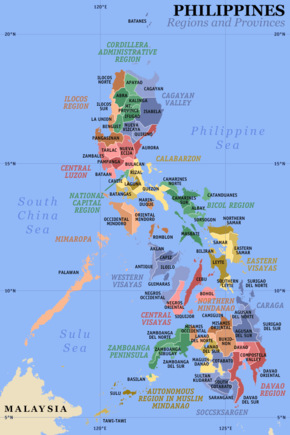Siquijor
| Siquijor | |||
|---|---|---|---|
| — Province — | |||
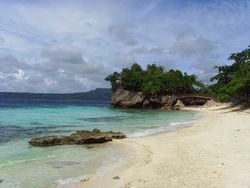 |
|||
|
|||
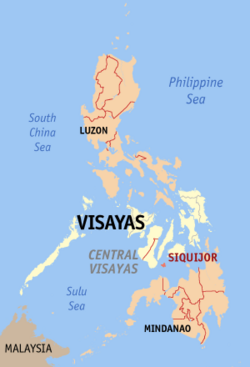 |
|||
| Coordinates: | |||
| Country | |||
| Region | Central Visayas (Region VII) | ||
| Founded | September 17, 1971 | ||
| Capital | Siquijor | ||
| Government | |||
| - Governor | Orlando Fua, Jr. (Lakas-Kampi-CMD) | ||
| Area | |||
| - Total | 337.5 km2 (130.3 sq mi) | ||
| Area rank | 78th out of 80 | ||
| Population (2007) | |||
| - Total | 87,695 | ||
| - Rank | 78th out of 80 | ||
| - Density | 259.8/km2 (673/sq mi) | ||
| - Density rank | 25th out of 80 | ||
| Divisions | |||
| - Independent cities | 0 | ||
| - Component cities | 0 | ||
| - Municipalities | 6 | ||
| - Barangays | 134 | ||
| - Districts | Lone district of Siquijor | ||
| Time zone | PHT (UTC+8) | ||
| ZIP Code | |||
| Spoken languages | Cebuano | ||
Siquijor (Filipino:Sikwihor) is an island province of the Philippines located in the Central Visayas region. Its capital is the municipality also named Siquijor. To the northwest of Siquijor are Cebu and Negros, to the northeast is Bohol and to the south, across the Bohol Sea is Mindanao.
Siquijor is the third smallest province in the country both in terms of population and land area, after Camiguin and Batanes. For a time it was sub-province of Negros Oriental. Called Isla del Fuego or the “Island of Fire” by the Spanish before, Siquijor is considered by many Filipinos to be a mystical island, full of witches and other supernatural phenomena.
Contents |
History
The Spaniards called Siquijor Isla del Fuego or “Island of Fire,” because the island gave off an eerie glow. This glow came from the great swarms of fireflies that harbored in the numerous molave trees on the island.
The island was first sighted by the Spaniards in 1565 during Miguel López de Legaspi's expedition. Since then, the island came under Spanish rule and the present municipalities, with the exception of Enrique Villanueva were established as Catholic parishes. The first parish, Siquijor, was established in 1783 under the administration of secular clergymen. In the years that followed until 1877, the parishes of Larena (Cano-an), Lazi (Tigbawan), San Juan (Makalipay), and Maria (Cangmeniac) were founded by priests of the Augustinian, Recollects.
From 1854 to 1892, the island was administered by Spain under the politico-military province of Bohol. In 1892, it became a part of Negros Oriental, and then its sub-province in 1901.
On 1942, Japanese Imperial forces landed in the island of Siquijor as part of their occupation of the Philippines. On 1945, Philippine Commonwealth troops landed on the beaches in the island and defeated the Japanese Imperial forces during the Battle of Siquijor in World War II.
On September 17, 1971, Siquijor became an independent province by virtue of Republic Act No. 6396. The capital which was formerly Larena, was transferred to the municipality of Siquijor in 1972 with Proclamation No. 1075.
Geography
Siquijor is an island province in the Visayas. It lies southeast from Cebu and Negros across Cebu Strait (in some references called Bohol Strait) and southwest from Bohol. Panglao Island which is part of Bohol province has a similar composition of the soil which was also found in the whole island of Siquijor. Bohol is also located north of Mindanao separated by the Bohol Sea.
With a land area of 343.5 km² and a coastline 102 km long, Siquijor is the 3rd smallest province of the Philippines. The highest peak at the center of the island is Mount Bandilaan.
The climate in Siquijor like most of the rest of the country is very tropical. It is dry from January to May and wet the rest of the year. Annual rainfall is 1000 to 1300 millimeters with November having the heaviest rainfall and April having the least. Siquijor has an average temperature of 28 °C and a humidity of 78%.
Political subdivisions
Siquijor is subdivided into 6 municipalities. Siquijor is the capital and most important port.
Six municipalities comprise the province.
- Enrique Villanueva
- Larena
- Lazi
- Maria
- San Juan
- Siquijor
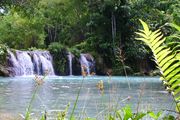
Tourism
Siquijor's reputation as a place of magic and sorcery both attracts visitors and keeps them away.[1][2]
Among the tourist attractions in Siquijor are beaches, caves, Bandilaan Natural Park, and a butterfly sanctuary.[3][4][5][6]
Siquijor is also praised for its clean and plentiful beaches, and is hailed as one of the best sites for diving in the country, with plentiful healthy coral and fish.[7] Visitors will find the beaches are open for access by all tourists. Varied lodging choices are available for visitors. Choices include a wide range of beach resorts [8][9]
Siquijor is quickly becoming a prime destination in the Philippines because of it's natural beauty, warm people, safety, and peaceful island lifestyle. During 2007 the data from the Department of Tourism show that Siquijor posted the highest growth in visitor arrivals among the four provinces in region 7. Tourist arrivals in the province rose 21.4 percent from the previous year.[10]
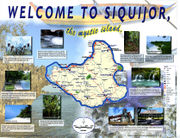
Transportation
Siquijor has 3 ports that are capable of servicing cargo and passenger craft. From the port of Larena you can travel to Dumaguete via Negros Navigation. In The Municipality of Siquijor you can travel by Delta Fast Ferries, Inc., a fast craft services company plies the route to/from the City of Dumaguete. Smaller vessels include the "Jaylan's 1 & 2". From Lazi, you can travel to Mindanao via the "MV Siquijor Island"
External links
- http://www.gmanews.tv/video/39840/Siquijor-as-a-summer-destination
- http://dost-siquijor-ipv6-ready.blogspot.com
- http://www.facebook.com/album.php?aid=155359&id=721050826
References
- ↑ Who's afraid of Siquijor column
- ↑ "Shamans of Siquijor:" A documentary film series about shamanistic folk practitioners on Siquijor." [1]
- ↑ [2]
- ↑ visayandailystar.com, Butterfly sanctuary launched in Siquijor
- ↑ pia.gov.ph, Island butterfly sanctuary now open for tourists
- ↑ gmanews.tv, Butterfly sanctuary inaugurated in Siquijor
- ↑ Siquijor Dive Shop
- ↑ Siquijor beach resorts
- ↑ Siquijor beach resorts2
- ↑ [3]
|
|||||
